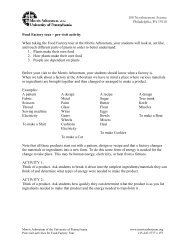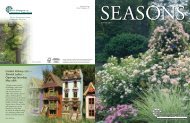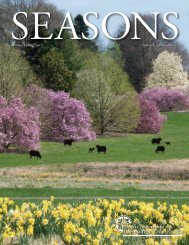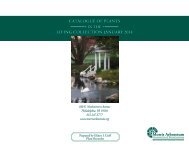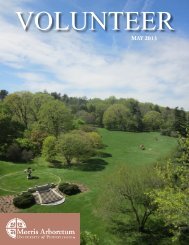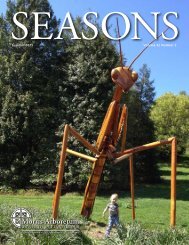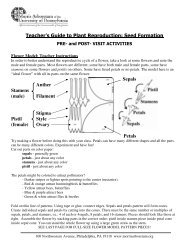Great Treestour - Business Services - University of Pennsylvania
Great Treestour - Business Services - University of Pennsylvania
Great Treestour - Business Services - University of Pennsylvania
You also want an ePaper? Increase the reach of your titles
YUMPU automatically turns print PDFs into web optimized ePapers that Google loves.
1. Bender oak<br />
Quercus × benderi<br />
• Native to eastern North America; a<br />
naturally occurring hybrid between<br />
scarlet oak (Q. coccinea) and red oak<br />
(Q. rubra).<br />
• Possibly 250 years old, the tree provided<br />
a dramatic entrance to the Morris garden and hilltop home.<br />
• Noted for its branch structure in winter, shiny green leaves<br />
in summer, and red fall color.<br />
2. Ginkgo, maidenhair-tree<br />
Ginkgo biloba<br />
• One <strong>of</strong> the world’s oldest tree species,<br />
growing on earth for well over 150<br />
million years.<br />
• With striking gold fall color, this female<br />
specimen, planted by the Morrises,<br />
has messy and very smelly fruit. Non-fruiting males make<br />
excellent city trees.<br />
• A male specimen is near the Edith Bogue magnolia (6).<br />
3. Weeping European beech<br />
Fagus sylvatica f. pendula<br />
• Native to Europe, planted before 1909 by<br />
the Morrises.<br />
• Branches weep down and form roots<br />
where they touch the ground. New rings<br />
<strong>of</strong> trees grow outward as the original tree<br />
ages and dies.<br />
• An impressive tree in all seasons with its smooth gray<br />
elephant hide-like bark, lustrous green leaves in summer, and<br />
red to golden brown fall color.<br />
• Small holes in trunk are made by sap sucking birds.<br />
4. Blue Atlas cedar<br />
Cedrus atlantica ‘Glauca’<br />
PA PA<br />
• The straight species is native to the Atlas<br />
Mountains <strong>of</strong> North Africa.<br />
• Layered branches with blue-green<br />
needles create a picturesque landscape<br />
tree.<br />
• Small finger-shaped male cones on lower branches pollinate<br />
attractive large beehive-shaped female cones above.<br />
5. Giant-sequoia<br />
Sequoiadendron giganteum<br />
• Native to California. Sequoia National<br />
Park is the home <strong>of</strong> the national<br />
champion, 275 feet by 107 feet.<br />
• Related to the coastal redwood <strong>of</strong><br />
California and the Metasequoia<br />
(dawn-redwood).<br />
• Orange bark <strong>of</strong> these trees accents the orange theme <strong>of</strong> this<br />
garden area. Note the state champion paperbark maple (Acer<br />
griseum) nearby.<br />
6. Edith Bogue southern magnolia<br />
Magnolia grandiflora ‘Edith Bogue’<br />
• This cultivar is a descendent <strong>of</strong> a tree in<br />
Edith Bogue’s New Jersey garden that<br />
survived a particularly harsh winter.<br />
• A spectacular tree in all seasons: large<br />
lemon-scented creamy white flowers<br />
in spring/summer, bright red seeds set<br />
in velvety fall fruit, and lustrous dark<br />
evergreen leaves.<br />
• Ornamental leaves ideal for decorative arrangements.<br />
7. Katsura-tree<br />
Cercidiphyllum japonicum<br />
• Native to Japan and China, planted<br />
around 1902 by the Morrises.<br />
• One <strong>of</strong> the largest <strong>of</strong> its kind in North<br />
America, this plant is the signature tree<br />
<strong>of</strong> the Arboretum.<br />
• Bright yellow/apricot leaves in fall release a spicy cinnamon/<br />
brown sugar aroma.<br />
8. Lacebark pine<br />
Pinus bungeana<br />
• Native to China, this stately lacebark<br />
pine, is one <strong>of</strong> the largest in the<br />
Delaware Valley.<br />
• Striking exfoliating bark changes color<br />
with age and moisture.<br />
• Fine-textured foliage gives an airiness to the crown.<br />
9. Hardy Cedar-<strong>of</strong>-Lebanon<br />
Cedrus libani ssp. stenocoma<br />
• This subspecies is native to the mountains<br />
<strong>of</strong> southwest Turkey and has an upright<br />
habit.<br />
• The straight species, known for its historic<br />
stands in Lebanon, has more widespreading<br />
branches.<br />
10. Japanese zelkova<br />
Zelkova serrata<br />
• Native to China, Korea and Japan, this<br />
tree has been growing at the Arboretum<br />
since the Morrises’ time.<br />
• Often used as a street tree, it has<br />
beautiful bark, a vase shape and<br />
red-orange fall color.<br />
PA<br />
PA



